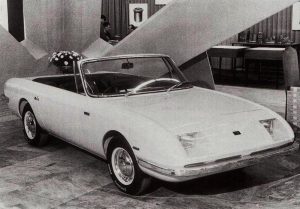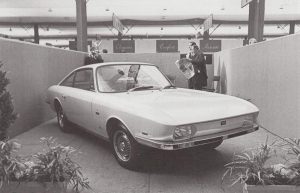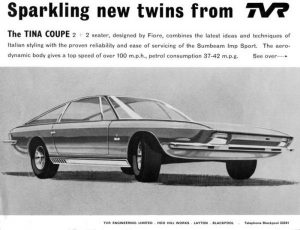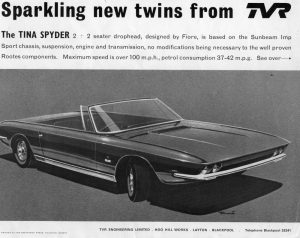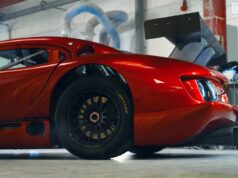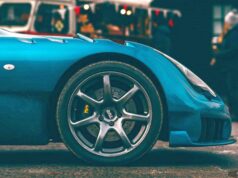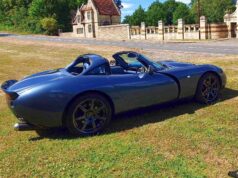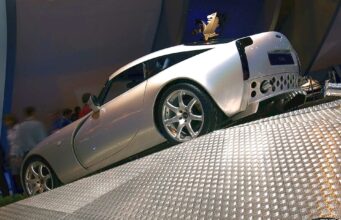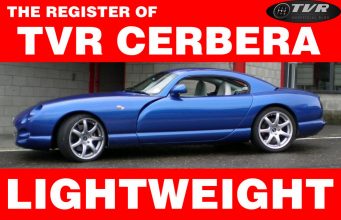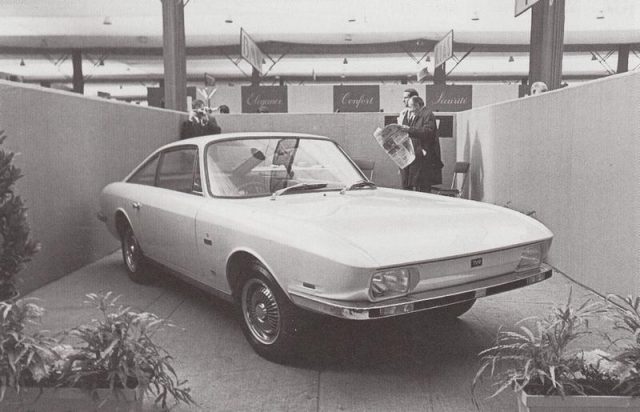
In November 1966 TVR presented the Tina at the Turin Motor Show. The car was based upon the Hillman Imp, and as was characteristic of TVR’s at the time, it retained many of the component parts of the ‘Donor’ vehicle, which is of course how TVR got it’s reputation for being a kit car. This model was a 2+2 convertible sports car and was designed by Trevor Fiore. The body shell was built by Carrozzeria Fissore in Italy, and uncharacteristically for TVR, this was made of steel. However, the steel construction was only for the benefit of the prototype, as in all probability any future production models would be made from reinforced glass fibre, as TVR did not have any body pressing capability.
The engine, floor pan and transmission were all from the Hillman Imp Sport, as were most of the mechanical components, even down to the wheel trims on a modified version. Such was the disorganised chaos involved in preparing the car for the show, and in typical TVR fashion for that era, a Ford Cortina name badge was modified by having the letters Cor snapped off, thus leaving the word tina. This was the badge displayed on the car for the show. The TVR Tina was actually named after the daughter of Gerry Marshall, who at the time was a driver of a TVR race car and a complete fan of the marque.
The original prototype had a smooth front end that was neatly rounded so as to minimise airflow disturbance, and Perspex covers over the square headlights. This design had been the subject of criticism by the press, and so the car was returned to Fissore for modifications to be made. Fissore was still working on another version of the Tina, a fixed head coupe, that he was trying to get ready for the London Motor Show.
The concept of the Tina had been decided upon on account of flagging sales for the mainstream TVR model line-up, and Martin Lilley thought that if TVR could produce a more economical sports car this would tide them over so as to ride out the crises. Lilley wanted both the coupe and the convertible to be ready in time for the London Motor Show as he thought it important for image that the company demonstrated the appearance of well being.
The nose of the car was restyled, and the car appeared at London with a rather blunt front end with the coupe sporting a single pair of rectangular headlights, whereas the convertible had a double pair of round ones. Also on the stand at this time were TVR’s Tuscan V8 and the first Vixen, albeit the Tuscan appeared only as a bare running chassis. Despite the hasty preparation of the two new models they were seen as an instant success with many people offering to put down their deposit to secure orders on the day. Even after the show, TVR were inundated with enquiries for orders of the new car.
TVR now had a problem. They had a design of car that many people wanted, but did not have the capacity to build it, and certainly no equipment to produce steel bodies or panels. The parent company of the Hillman Imp, Rootes, were approached, as were Jensen and Aston Martin in an attempt to find someone who could help out in what was TVR’s hour of need.
Rootes were not keen on helping as they believed there would be a conflict of interest on account of the Tina being too close to their own Sunbeam Alpine. Jensen were not convinced there would be sufficient demand for the car to make their involvement worthwhile, and Aston Martin was in enough financial difficulty at the time to want to take on another potential liability.
TVR tried to fabricate a glass fibre body that was bonded to the Imp sub frame, but this was not successful, this being attempted as it was thought the all steel body would actually too heavy for the little Imp engine.
The Tina coupe re-appeared at the Turin Motor Show in 1967 where it was exposed as a 100mph sports car that would still return over 40-miles to a gallon of fuel. Claims were made by TVR that full production of the car would begin in early 1968, when the on the road price would be just shy of £1,000. Unfortunately, all the great promises never cam true, and after consuming of £15,000 in costs, the Tina project was scrapped.
A great source for this stuff is here: http://www.imps4ever.info/specials/tvrtina.html7

